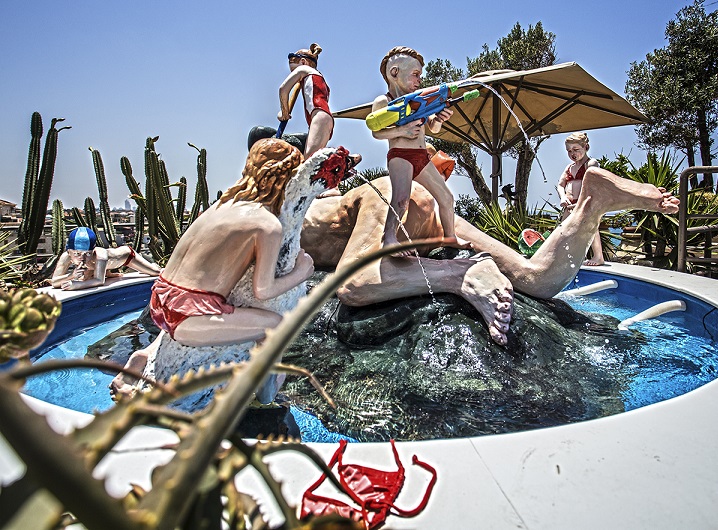The Fountain | Vered Aharonovitch
Vered Aharonovitch
- Date2014
- TechniqueMixed media: fiberglass, wood, iron and water pumps
- Size300X300X250
The installation The Fountain, positioned on the Ilana Goor Museum rooftop, presents an unpredictable plot. At first glance, we see the figure of an athletic man, recumbent on a rock island, with “mischievous” girls running around him, seemingly playing within his territory. The figure of the man summons the iconic Poseidon from Greek mythology (or Neptune in Roman mythology), the hedonist God of the Sea. However, at a second glance a role reversal is revealed. The God is not admired and has no control over his subjects. The obvious inspiration for this work is the classic sovereignty scene of the Fontana Di Trevi in Rome (1629-1762), which demonstrates Neptune’s control over the sea through his army of tritons and horses.
In a kind of compensatory act, Vered Aharonovitch, painter and sculptor who graduated from the Bezalel Academy, chooses to project her inner world upon one of the central urban icons in architectural and visual history, as well as today - the fountain. She creates a satirical grotesque scene corresponding with the fairytale tradition: “Once upon a time... and they all lived happily ever after.” But no! The redheaded girl is a reflection of the mischievous controversial figure of Pippi Longstocking, created by author Astrid Lindgren, star of children’s television in the 1980s.
The sculptural installation presents naked Poseidon not as a powerful God, but as a defeated, humiliated weakling, in the midst of our existence, with a horrified look on his face, and five little girls tormenting him with a touch of black comedy and the absurd. They have none of the seduction typical to sculptures of children’s play. They project post-terror anger, a sense of revenge following their disillusionment, when they came to acknowledge a villainous act that was committed.
Aharonovitch’s industrial colorfulness corresponds with the seemingly-naïve sculptures of Niki de Saint Phalle (1930-2002). Her playful sculpture The Golem (1972) is used to this day as a slide in the Kiryat Yovel playground in Jerusalem, and the installation The Fountain (1982), which she co-created with her husband the sculptor Jean Tinguely, is positioned outside the Centre Georges Pompidou in Paris.
Aharonovitch chooses to work with plastic, a material which Roland Barth describes as alchemical, altered, belittled and bourgeois. According to Barth, this material was used as a futuristic replacement of materials previously perceived noble (marble and bronze). In Aharonovitch’s installation, the plastic material invites a new dialogue, one that has been made possible by the feminist revolution. The spectacular representation raises and contains problematic issues that Western society attempts to address, though to no avail.
Another inspiration for the work is hidden in its title. This is a reference to the subversive – The Fountain by Marcel Duchamp, one of the most influential artists of the 20th century. Duchamp’s fountain is no other than an industrial porcelain urinal which he put on the artistic pedestal in 1917. This act became a turning point in art, which chose to take the industrial mundane object out of its context as part of the modern formative lexicon. Aharonovitch continues to develop this notion, which announces a conceptual revolution in the way object and subject relations are perceived, and appropriates it to a humorous drama. Through her naïve aesthetic treatment of material and color and in her own unique manner, the artist raises issues of sovereignty, breach of trust, and abuse.
Written by: Sophia Dekel Caspi 2015

Photography: Shuki Kook
